Second Avenue Subway—Phase One
New York City
Region ENR New York
Airport/Transit
Project Team
Owner MTA-Capital Construction Co.
Lead Design Firm/Engineer: AECOM-Arup JV (Structural, Civil and MEP)
Design Team: GZA, Naik, Domingo Gonzalez Associates
Construction Manager WSP (Formerly WSP/Parsons Brinckerhoff)
General Contractor S3 Tunnel Connectors JV (Skanska USA, Schiavone Construction Co. and J.F. Shea Construction Inc.)
Contractors Traylor Bros Inc.; L.K. Comstock & Co.; E.E. Cruz & Co.; Tully Construction; Kiewit Construction Co.; Judlau-OHL; John Picone; D’Annunzio & Sons
Building the first major new New York City subway line in decades in a demographically, geologically and politically challenged environment was no easy feat for the team that completed phase one of the Second Avenue Subway (SAS).
The $4.5-billion project, which opened on Jan. 1, 2017, is the first of four planned sections of what will be an eight-mile route that will provide needed congestion relief on Manhattan’s East Side.
Three new stations along the completed 1.8-mile route—at 96th, 86th and 72nd streets—rank among North America’s largest underground excavations at nearly 64 ft wide, 100 ft deep and 1,600 ft long, setting new standards for design of a modern station, says the project team. One Best of the Best judge termed the project “an architectural gem.”
Tunnel boring excavated 12,800 ft of twin-track, 22-ft-dia. tubes, the city’s first to use steel and polypropylene fibers instead of rebar in the final liner to boost strength and safety, submitters say.
Richard Giffen, Arup chief structural engineer, notes modifications of high-rise foundations and utilities that “drop down into the project.” The team also describes as “a herculean endeavor” the complex connections on a 100-year-old transit system to the existing 63rd Street station and to previously bored tunnels north of the first-phase route that will be key in phase two.
“Geology … was studied for many years during the design phase of the project but still managed to provide a few surprises,” says Tom Peyton, project manager for SAS construction manager WSP. Despite multiple borings, he notes the late-stage need for ground-freezing in one area of softer soil and unstable rock that would have threatened construction progress south of 91st Street.
Janno Lieber, a former developer named last April to a newly created top role of chief development officer at owner MTA Capital Construction Co., says environmental and residential concerns were among the biggest challenges, with more than 100,000 residents per square mile in the area. The team boosted public outreach during construction to mitigate complaints, particularly over blasting and air quality, that could have derailed or even halted the project. “Muck houses” removed about 120,000 truckloads of spoils while containing noise and dust, says Lieber.
“The team learned from these complaints and changes were made,” says Peyton. “Those who lived along the tunnels might only have a few months of impact as [tunnel-boring machines] mined by, but people near the 96th Street station were impacted for almost 10 years of construction.”
With 32 subconsultants, 10 simultaneous contracts during construction and multiple building trades, effective “interfaces” were critical to keeping schedule and safety risks in check on a project reporting more than 15 million worker-hours. The team says the project’s OSHA-recordable incident rate of 2.8 overall and a lost-time incident rate of 1.38 “remained below industry standards.”
But with critical reports citing SAS as “the world’s most expensive subway” at $807 million per track mile for construction alone, cost containment will be a critical issue going forward in phase two, whose cost has risen, with inflation, from the originally estimated $4 billion to $6 billion.
One judge said he was “blown away” by the cost of phase one.
MTA has earmarked $1.74 billion for environmental, design and utility-relocation work for the next phase—from 96th Street to 125th Street and including three new stations—but it has to ante up $2.27 billion in construction funding in its next five-year capital program to gain another $2 billion in needed funds from the federal New Starts program that is set to merge into the proposed Trump infrastructure funding package, said former U.S. Transportation Dept. regional manager Larry Penner in a Feb. 21 online overview.
Once upfront design review finishes by late September, “we will be in a better position to develop a project schedule and cost,” Lieber says. “Funding for the project will carry over multiple capital plans.” WSP and STV were awarded in late 2016 the estimated $120-million phase-two design contract.
Recent analyses by The New York Times and the Regional Plan Association, a New York City region advocacy group, propose steps they say could cut costs on rail megaprojects such as SAS by 25% to 33%.
These include a temporary “special purpose entity” in MTA with sole project delivery authority, design-build for all new rail lines and extensions, streamlined labor practices, and performance bonuses for workers and contractors, which, they claim, can deliver lower-cost projects such as those abroad.
New York project observers point to inefficient “early 20th-century” contracting approaches and need for a phase-two project labor agreement and scaled-back stations.
In a statement, Joseph Lhota, MTA chairman, said a task force set up last year “is working to streamline the procurement process, stop customization of components, reduce change orders, chop huge costs and delays [in] utility relocations and more effectively manage projects across the board.”
MTA did not say when task force recommendations would be announced.
Lieber told ENR that design-build can better encourage project collaboration and innovation and “help to reduce delays from conflicts by intelligently allocating risk and responsibility between owner and builder.”
With early evidence of SAS-generated gain in real estate value along the route, future rail projects will likely have to incorporate the budding “value capture” concept in funding streams; it could also become a federal and state funding requirement.
Says Lieber: “In retrospect, it might have been wise to acquire more real estate … to enhance the streetscape and, potentially, to capture some of the value being created by the project.”







Post a comment to this article
Report Abusive Comment